BSBSUS401: Sustainability Proposal for Regency Stadium Recycling
VerifiedAdded on 2023/06/11
|10
|2166
|79
Report
AI Summary
This report presents a sustainability proposal for implementing a recycling program at Regency Stadium, addressing concerns raised about the stadium's environmental impact. The proposal outlines strategies for waste collection, handling, and disposal, aiming to establish a high-capacity waste handling plant that converts waste products into energy. It emphasizes the importance of stakeholder engagement, including discussions with both external entities like the government and waste management authorities, and internal stakeholders such as staff and the general public. The report sets strategic goals and sustainable targets, focusing on improving waste management through recycling and promoting environmental awareness. The implementation plan details how the strategies will be promoted to both internal and external stakeholders, along with methods for monitoring progress and reporting on the plan's effectiveness. The evaluation plan includes indicators of success and critical factors to control, with a focus on improving current waste management practices and fostering a culture of recycling within the stadium community. The proposal aims to enhance the stadium's environmental performance and contribute to a more sustainable future. Desklib provides access to similar reports and study tools for students.
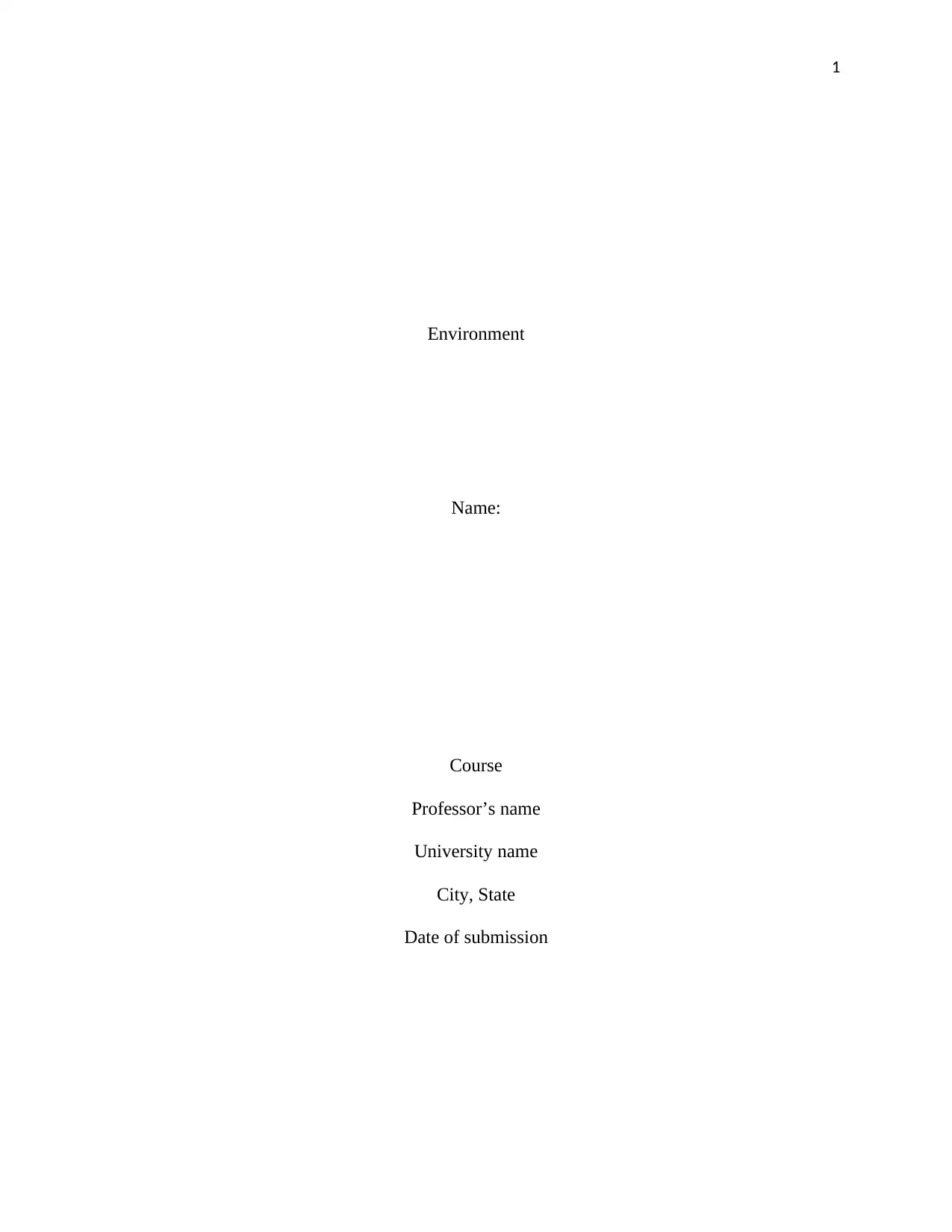
1
Environment
Name:
Course
Professor’s name
University name
City, State
Date of submission
Environment
Name:
Course
Professor’s name
University name
City, State
Date of submission
Paraphrase This Document
Need a fresh take? Get an instant paraphrase of this document with our AI Paraphraser
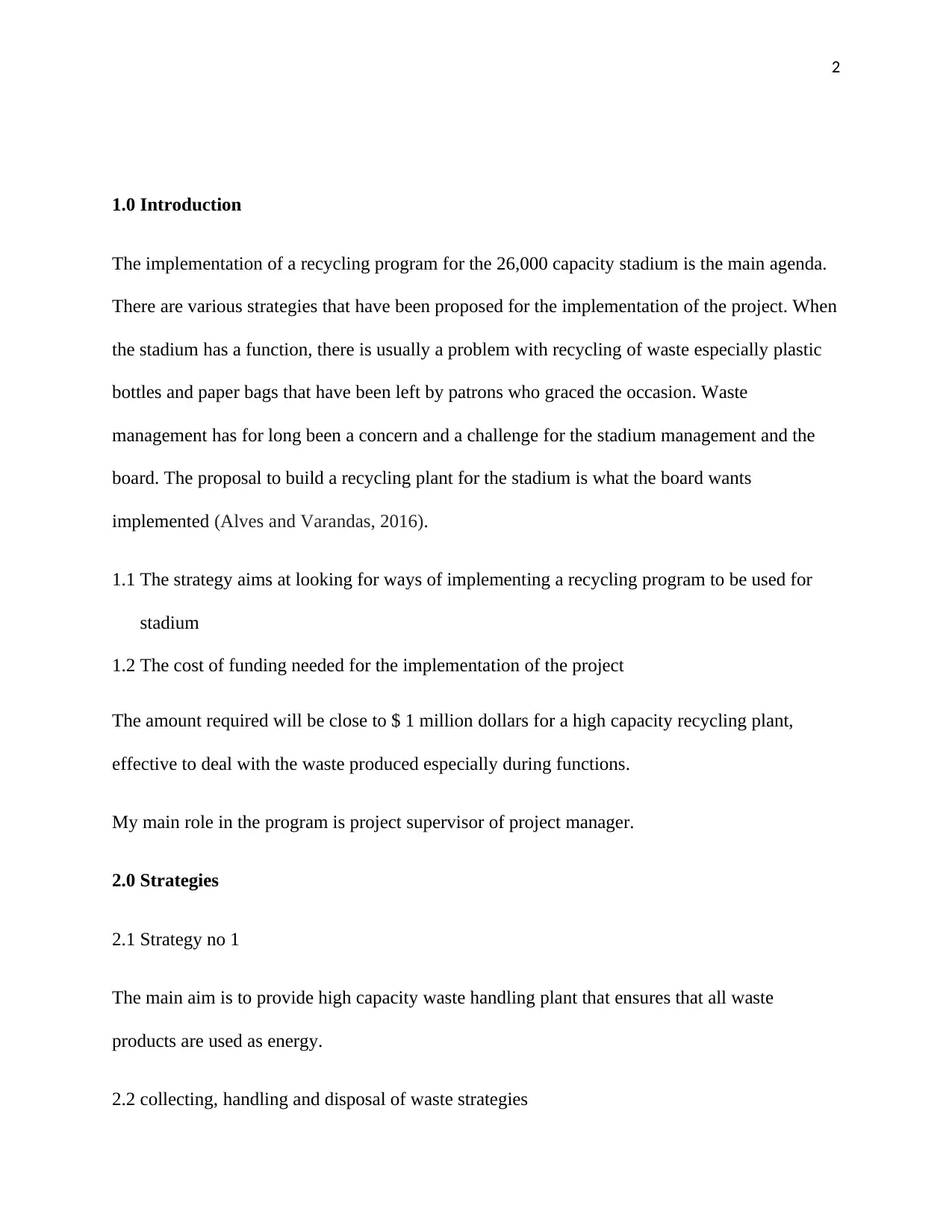
2
1.0 Introduction
The implementation of a recycling program for the 26,000 capacity stadium is the main agenda.
There are various strategies that have been proposed for the implementation of the project. When
the stadium has a function, there is usually a problem with recycling of waste especially plastic
bottles and paper bags that have been left by patrons who graced the occasion. Waste
management has for long been a concern and a challenge for the stadium management and the
board. The proposal to build a recycling plant for the stadium is what the board wants
implemented (Alves and Varandas, 2016).
1.1 The strategy aims at looking for ways of implementing a recycling program to be used for
stadium
1.2 The cost of funding needed for the implementation of the project
The amount required will be close to $ 1 million dollars for a high capacity recycling plant,
effective to deal with the waste produced especially during functions.
My main role in the program is project supervisor of project manager.
2.0 Strategies
2.1 Strategy no 1
The main aim is to provide high capacity waste handling plant that ensures that all waste
products are used as energy.
2.2 collecting, handling and disposal of waste strategies
1.0 Introduction
The implementation of a recycling program for the 26,000 capacity stadium is the main agenda.
There are various strategies that have been proposed for the implementation of the project. When
the stadium has a function, there is usually a problem with recycling of waste especially plastic
bottles and paper bags that have been left by patrons who graced the occasion. Waste
management has for long been a concern and a challenge for the stadium management and the
board. The proposal to build a recycling plant for the stadium is what the board wants
implemented (Alves and Varandas, 2016).
1.1 The strategy aims at looking for ways of implementing a recycling program to be used for
stadium
1.2 The cost of funding needed for the implementation of the project
The amount required will be close to $ 1 million dollars for a high capacity recycling plant,
effective to deal with the waste produced especially during functions.
My main role in the program is project supervisor of project manager.
2.0 Strategies
2.1 Strategy no 1
The main aim is to provide high capacity waste handling plant that ensures that all waste
products are used as energy.
2.2 collecting, handling and disposal of waste strategies
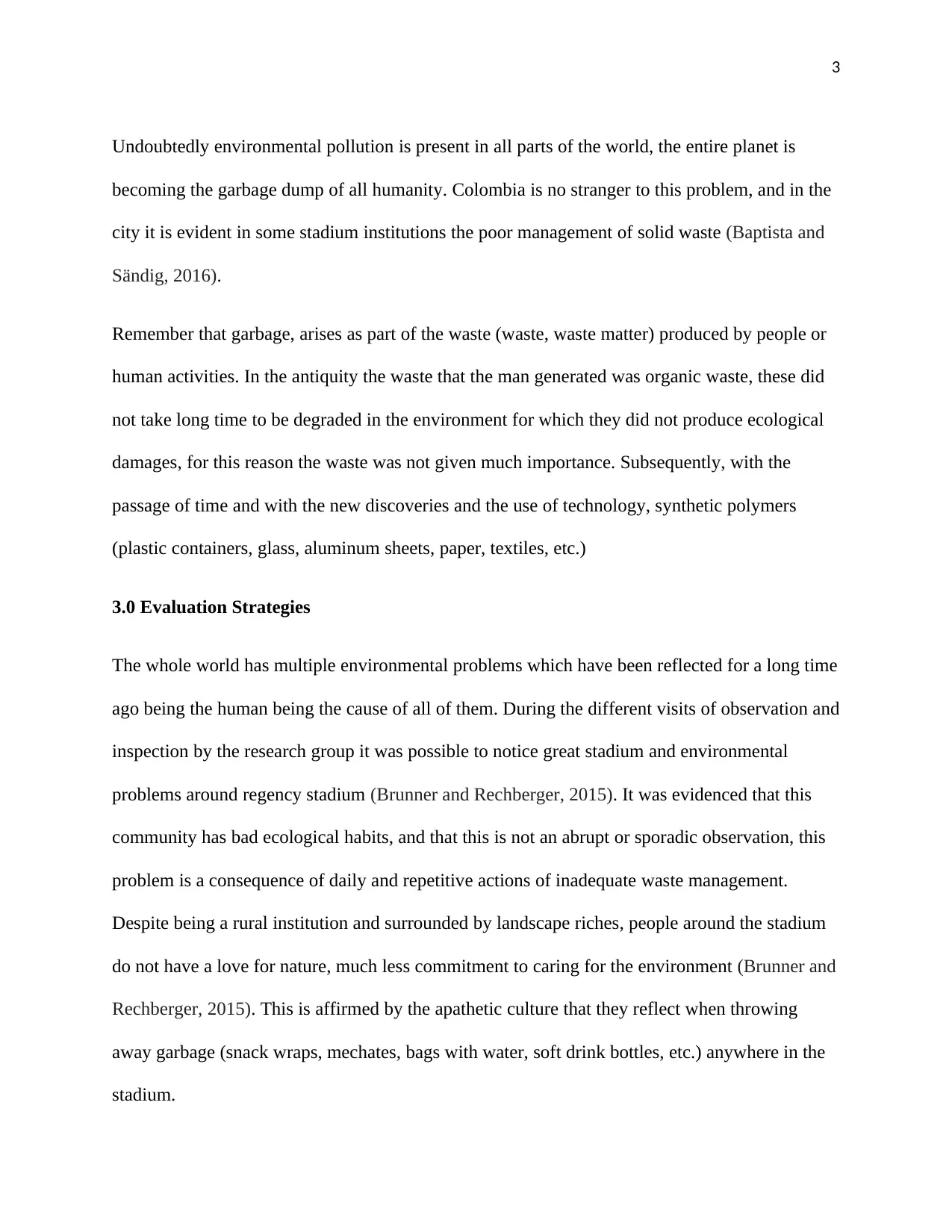
3
Undoubtedly environmental pollution is present in all parts of the world, the entire planet is
becoming the garbage dump of all humanity. Colombia is no stranger to this problem, and in the
city it is evident in some stadium institutions the poor management of solid waste (Baptista and
Sändig, 2016).
Remember that garbage, arises as part of the waste (waste, waste matter) produced by people or
human activities. In the antiquity the waste that the man generated was organic waste, these did
not take long time to be degraded in the environment for which they did not produce ecological
damages, for this reason the waste was not given much importance. Subsequently, with the
passage of time and with the new discoveries and the use of technology, synthetic polymers
(plastic containers, glass, aluminum sheets, paper, textiles, etc.)
3.0 Evaluation Strategies
The whole world has multiple environmental problems which have been reflected for a long time
ago being the human being the cause of all of them. During the different visits of observation and
inspection by the research group it was possible to notice great stadium and environmental
problems around regency stadium (Brunner and Rechberger, 2015). It was evidenced that this
community has bad ecological habits, and that this is not an abrupt or sporadic observation, this
problem is a consequence of daily and repetitive actions of inadequate waste management.
Despite being a rural institution and surrounded by landscape riches, people around the stadium
do not have a love for nature, much less commitment to caring for the environment (Brunner and
Rechberger, 2015). This is affirmed by the apathetic culture that they reflect when throwing
away garbage (snack wraps, mechates, bags with water, soft drink bottles, etc.) anywhere in the
stadium.
Undoubtedly environmental pollution is present in all parts of the world, the entire planet is
becoming the garbage dump of all humanity. Colombia is no stranger to this problem, and in the
city it is evident in some stadium institutions the poor management of solid waste (Baptista and
Sändig, 2016).
Remember that garbage, arises as part of the waste (waste, waste matter) produced by people or
human activities. In the antiquity the waste that the man generated was organic waste, these did
not take long time to be degraded in the environment for which they did not produce ecological
damages, for this reason the waste was not given much importance. Subsequently, with the
passage of time and with the new discoveries and the use of technology, synthetic polymers
(plastic containers, glass, aluminum sheets, paper, textiles, etc.)
3.0 Evaluation Strategies
The whole world has multiple environmental problems which have been reflected for a long time
ago being the human being the cause of all of them. During the different visits of observation and
inspection by the research group it was possible to notice great stadium and environmental
problems around regency stadium (Brunner and Rechberger, 2015). It was evidenced that this
community has bad ecological habits, and that this is not an abrupt or sporadic observation, this
problem is a consequence of daily and repetitive actions of inadequate waste management.
Despite being a rural institution and surrounded by landscape riches, people around the stadium
do not have a love for nature, much less commitment to caring for the environment (Brunner and
Rechberger, 2015). This is affirmed by the apathetic culture that they reflect when throwing
away garbage (snack wraps, mechates, bags with water, soft drink bottles, etc.) anywhere in the
stadium.
You're viewing a preview
Unlock full access by subscribing today!
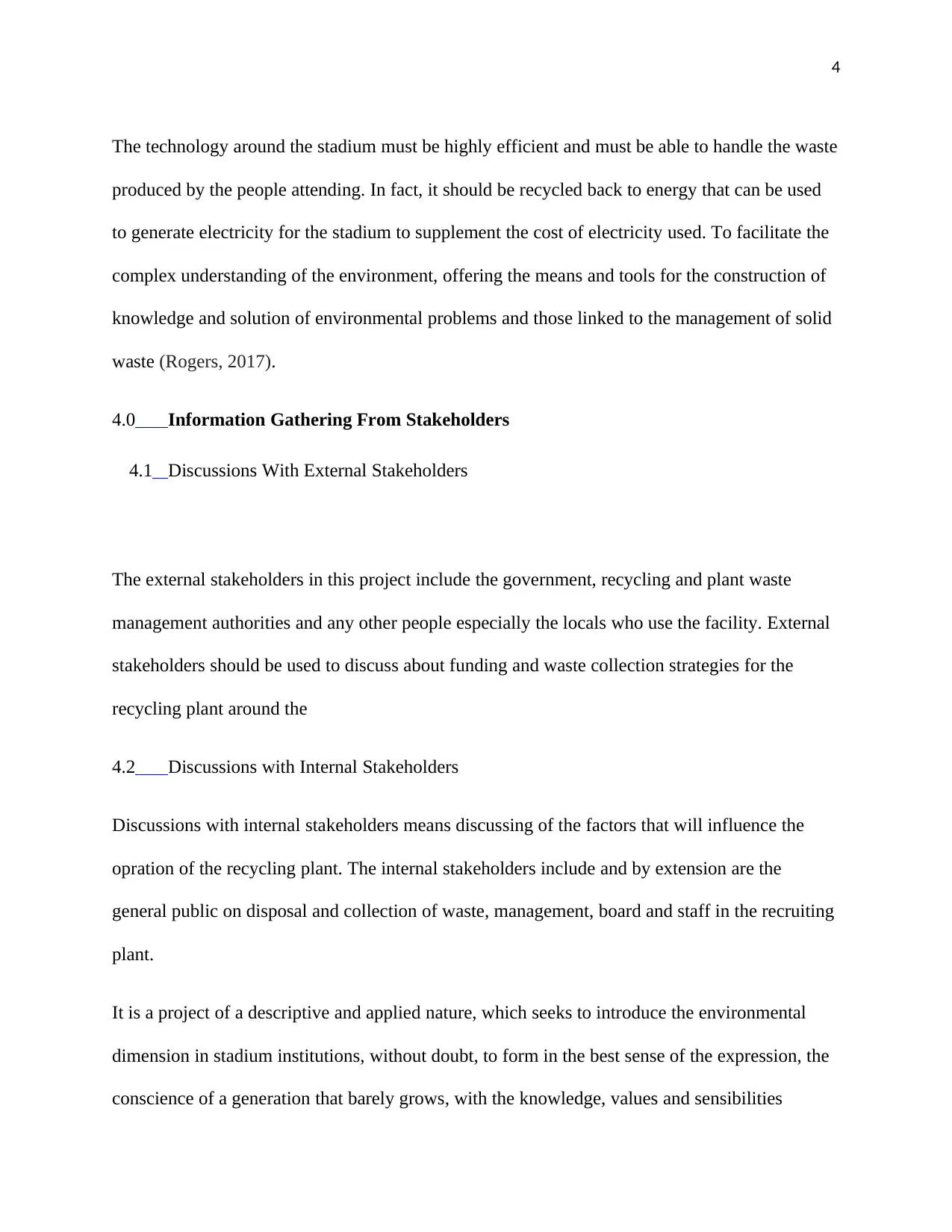
4
The technology around the stadium must be highly efficient and must be able to handle the waste
produced by the people attending. In fact, it should be recycled back to energy that can be used
to generate electricity for the stadium to supplement the cost of electricity used. To facilitate the
complex understanding of the environment, offering the means and tools for the construction of
knowledge and solution of environmental problems and those linked to the management of solid
waste (Rogers, 2017).
4.0 Information Gathering From Stakeholders
4.1 Discussions With External Stakeholders
The external stakeholders in this project include the government, recycling and plant waste
management authorities and any other people especially the locals who use the facility. External
stakeholders should be used to discuss about funding and waste collection strategies for the
recycling plant around the
4.2 Discussions with Internal Stakeholders
Discussions with internal stakeholders means discussing of the factors that will influence the
opration of the recycling plant. The internal stakeholders include and by extension are the
general public on disposal and collection of waste, management, board and staff in the recruiting
plant.
It is a project of a descriptive and applied nature, which seeks to introduce the environmental
dimension in stadium institutions, without doubt, to form in the best sense of the expression, the
conscience of a generation that barely grows, with the knowledge, values and sensibilities
The technology around the stadium must be highly efficient and must be able to handle the waste
produced by the people attending. In fact, it should be recycled back to energy that can be used
to generate electricity for the stadium to supplement the cost of electricity used. To facilitate the
complex understanding of the environment, offering the means and tools for the construction of
knowledge and solution of environmental problems and those linked to the management of solid
waste (Rogers, 2017).
4.0 Information Gathering From Stakeholders
4.1 Discussions With External Stakeholders
The external stakeholders in this project include the government, recycling and plant waste
management authorities and any other people especially the locals who use the facility. External
stakeholders should be used to discuss about funding and waste collection strategies for the
recycling plant around the
4.2 Discussions with Internal Stakeholders
Discussions with internal stakeholders means discussing of the factors that will influence the
opration of the recycling plant. The internal stakeholders include and by extension are the
general public on disposal and collection of waste, management, board and staff in the recruiting
plant.
It is a project of a descriptive and applied nature, which seeks to introduce the environmental
dimension in stadium institutions, without doubt, to form in the best sense of the expression, the
conscience of a generation that barely grows, with the knowledge, values and sensibilities
Paraphrase This Document
Need a fresh take? Get an instant paraphrase of this document with our AI Paraphraser
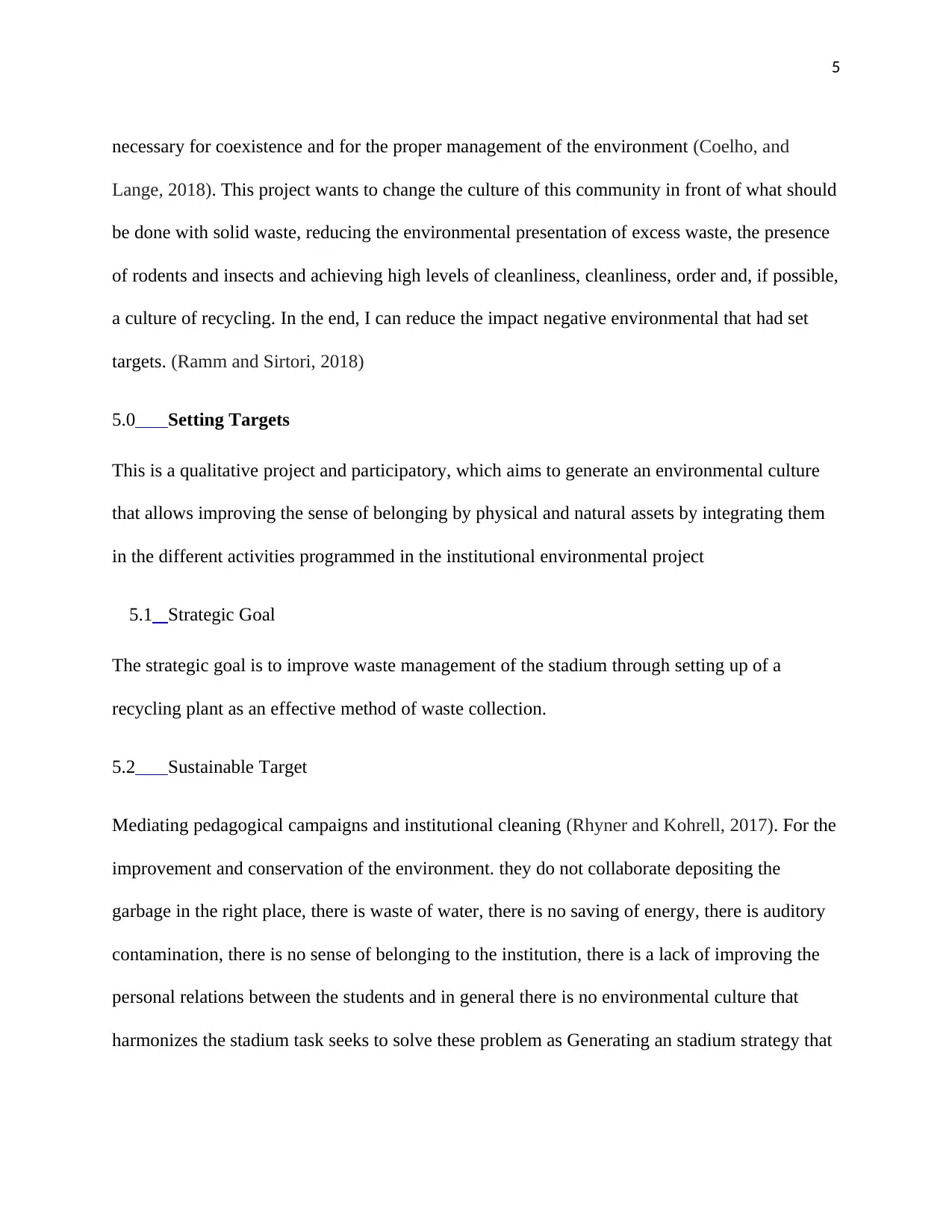
5
necessary for coexistence and for the proper management of the environment (Coelho, and
Lange, 2018). This project wants to change the culture of this community in front of what should
be done with solid waste, reducing the environmental presentation of excess waste, the presence
of rodents and insects and achieving high levels of cleanliness, cleanliness, order and, if possible,
a culture of recycling. In the end, I can reduce the impact negative environmental that had set
targets. (Ramm and Sirtori, 2018)
5.0 Setting Targets
This is a qualitative project and participatory, which aims to generate an environmental culture
that allows improving the sense of belonging by physical and natural assets by integrating them
in the different activities programmed in the institutional environmental project
5.1 Strategic Goal
The strategic goal is to improve waste management of the stadium through setting up of a
recycling plant as an effective method of waste collection.
5.2 Sustainable Target
Mediating pedagogical campaigns and institutional cleaning (Rhyner and Kohrell, 2017). For the
improvement and conservation of the environment. they do not collaborate depositing the
garbage in the right place, there is waste of water, there is no saving of energy, there is auditory
contamination, there is no sense of belonging to the institution, there is a lack of improving the
personal relations between the students and in general there is no environmental culture that
harmonizes the stadium task seeks to solve these problem as Generating an stadium strategy that
necessary for coexistence and for the proper management of the environment (Coelho, and
Lange, 2018). This project wants to change the culture of this community in front of what should
be done with solid waste, reducing the environmental presentation of excess waste, the presence
of rodents and insects and achieving high levels of cleanliness, cleanliness, order and, if possible,
a culture of recycling. In the end, I can reduce the impact negative environmental that had set
targets. (Ramm and Sirtori, 2018)
5.0 Setting Targets
This is a qualitative project and participatory, which aims to generate an environmental culture
that allows improving the sense of belonging by physical and natural assets by integrating them
in the different activities programmed in the institutional environmental project
5.1 Strategic Goal
The strategic goal is to improve waste management of the stadium through setting up of a
recycling plant as an effective method of waste collection.
5.2 Sustainable Target
Mediating pedagogical campaigns and institutional cleaning (Rhyner and Kohrell, 2017). For the
improvement and conservation of the environment. they do not collaborate depositing the
garbage in the right place, there is waste of water, there is no saving of energy, there is auditory
contamination, there is no sense of belonging to the institution, there is a lack of improving the
personal relations between the students and in general there is no environmental culture that
harmonizes the stadium task seeks to solve these problem as Generating an stadium strategy that
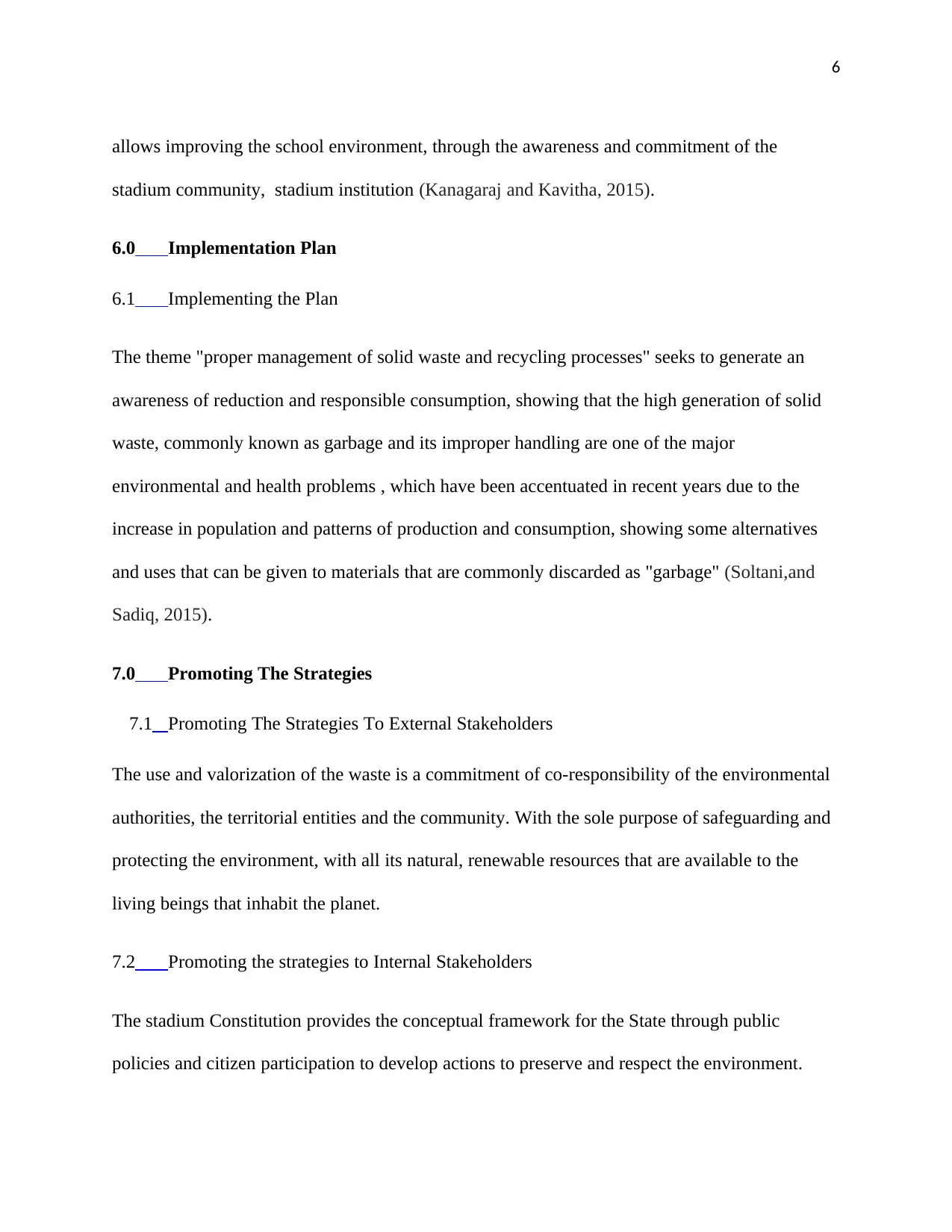
6
allows improving the school environment, through the awareness and commitment of the
stadium community, stadium institution (Kanagaraj and Kavitha, 2015).
6.0 Implementation Plan
6.1 Implementing the Plan
The theme "proper management of solid waste and recycling processes" seeks to generate an
awareness of reduction and responsible consumption, showing that the high generation of solid
waste, commonly known as garbage and its improper handling are one of the major
environmental and health problems , which have been accentuated in recent years due to the
increase in population and patterns of production and consumption, showing some alternatives
and uses that can be given to materials that are commonly discarded as "garbage" (Soltani,and
Sadiq, 2015).
7.0 Promoting The Strategies
7.1 Promoting The Strategies To External Stakeholders
The use and valorization of the waste is a commitment of co-responsibility of the environmental
authorities, the territorial entities and the community. With the sole purpose of safeguarding and
protecting the environment, with all its natural, renewable resources that are available to the
living beings that inhabit the planet.
7.2 Promoting the strategies to Internal Stakeholders
The stadium Constitution provides the conceptual framework for the State through public
policies and citizen participation to develop actions to preserve and respect the environment.
allows improving the school environment, through the awareness and commitment of the
stadium community, stadium institution (Kanagaraj and Kavitha, 2015).
6.0 Implementation Plan
6.1 Implementing the Plan
The theme "proper management of solid waste and recycling processes" seeks to generate an
awareness of reduction and responsible consumption, showing that the high generation of solid
waste, commonly known as garbage and its improper handling are one of the major
environmental and health problems , which have been accentuated in recent years due to the
increase in population and patterns of production and consumption, showing some alternatives
and uses that can be given to materials that are commonly discarded as "garbage" (Soltani,and
Sadiq, 2015).
7.0 Promoting The Strategies
7.1 Promoting The Strategies To External Stakeholders
The use and valorization of the waste is a commitment of co-responsibility of the environmental
authorities, the territorial entities and the community. With the sole purpose of safeguarding and
protecting the environment, with all its natural, renewable resources that are available to the
living beings that inhabit the planet.
7.2 Promoting the strategies to Internal Stakeholders
The stadium Constitution provides the conceptual framework for the State through public
policies and citizen participation to develop actions to preserve and respect the environment.
You're viewing a preview
Unlock full access by subscribing today!
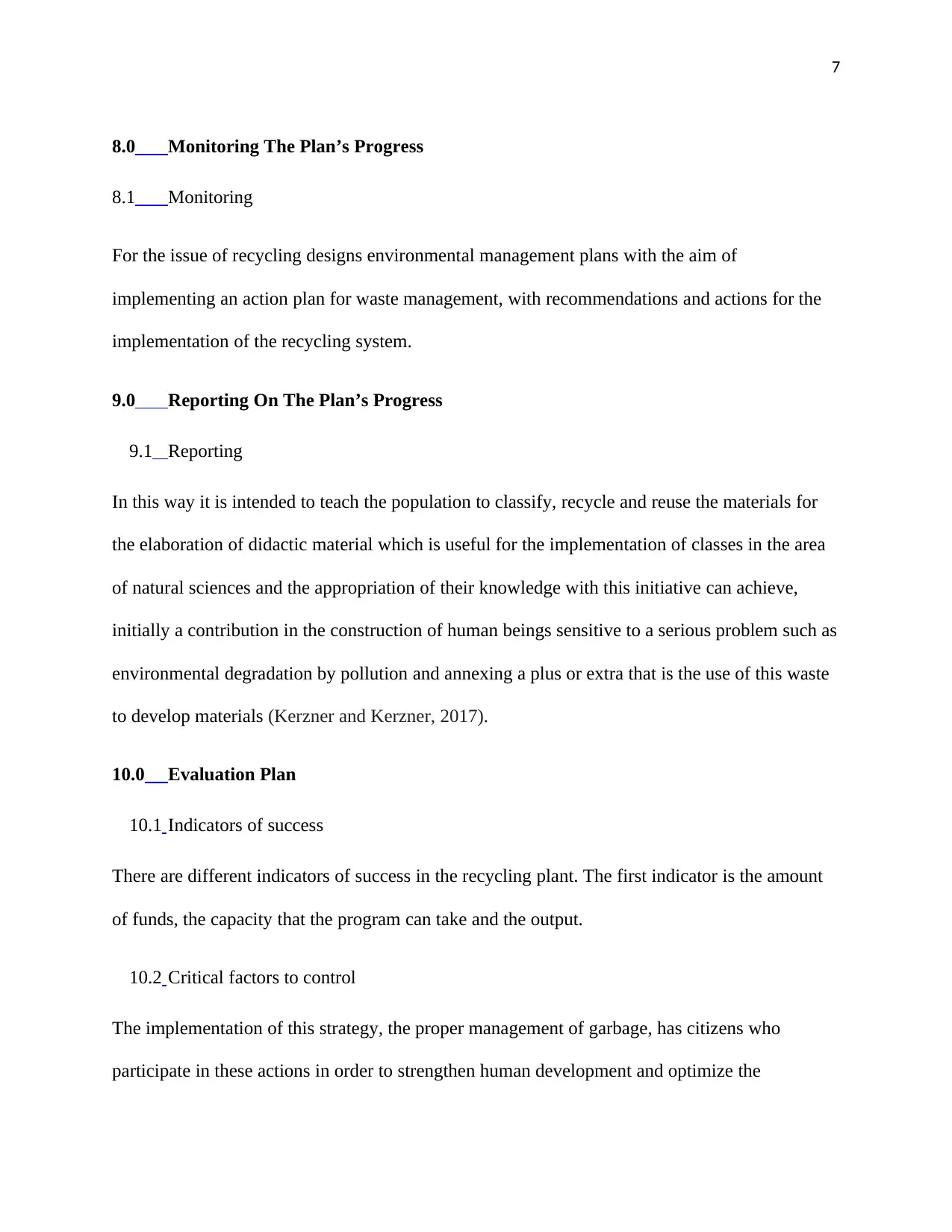
7
8.0 Monitoring The Plan’s Progress
8.1 Monitoring
For the issue of recycling designs environmental management plans with the aim of
implementing an action plan for waste management, with recommendations and actions for the
implementation of the recycling system.
9.0 Reporting On The Plan’s Progress
9.1 Reporting
In this way it is intended to teach the population to classify, recycle and reuse the materials for
the elaboration of didactic material which is useful for the implementation of classes in the area
of natural sciences and the appropriation of their knowledge with this initiative can achieve,
initially a contribution in the construction of human beings sensitive to a serious problem such as
environmental degradation by pollution and annexing a plus or extra that is the use of this waste
to develop materials (Kerzner and Kerzner, 2017).
10.0 Evaluation Plan
10.1 Indicators of success
There are different indicators of success in the recycling plant. The first indicator is the amount
of funds, the capacity that the program can take and the output.
10.2 Critical factors to control
The implementation of this strategy, the proper management of garbage, has citizens who
participate in these actions in order to strengthen human development and optimize the
8.0 Monitoring The Plan’s Progress
8.1 Monitoring
For the issue of recycling designs environmental management plans with the aim of
implementing an action plan for waste management, with recommendations and actions for the
implementation of the recycling system.
9.0 Reporting On The Plan’s Progress
9.1 Reporting
In this way it is intended to teach the population to classify, recycle and reuse the materials for
the elaboration of didactic material which is useful for the implementation of classes in the area
of natural sciences and the appropriation of their knowledge with this initiative can achieve,
initially a contribution in the construction of human beings sensitive to a serious problem such as
environmental degradation by pollution and annexing a plus or extra that is the use of this waste
to develop materials (Kerzner and Kerzner, 2017).
10.0 Evaluation Plan
10.1 Indicators of success
There are different indicators of success in the recycling plant. The first indicator is the amount
of funds, the capacity that the program can take and the output.
10.2 Critical factors to control
The implementation of this strategy, the proper management of garbage, has citizens who
participate in these actions in order to strengthen human development and optimize the
Paraphrase This Document
Need a fresh take? Get an instant paraphrase of this document with our AI Paraphraser
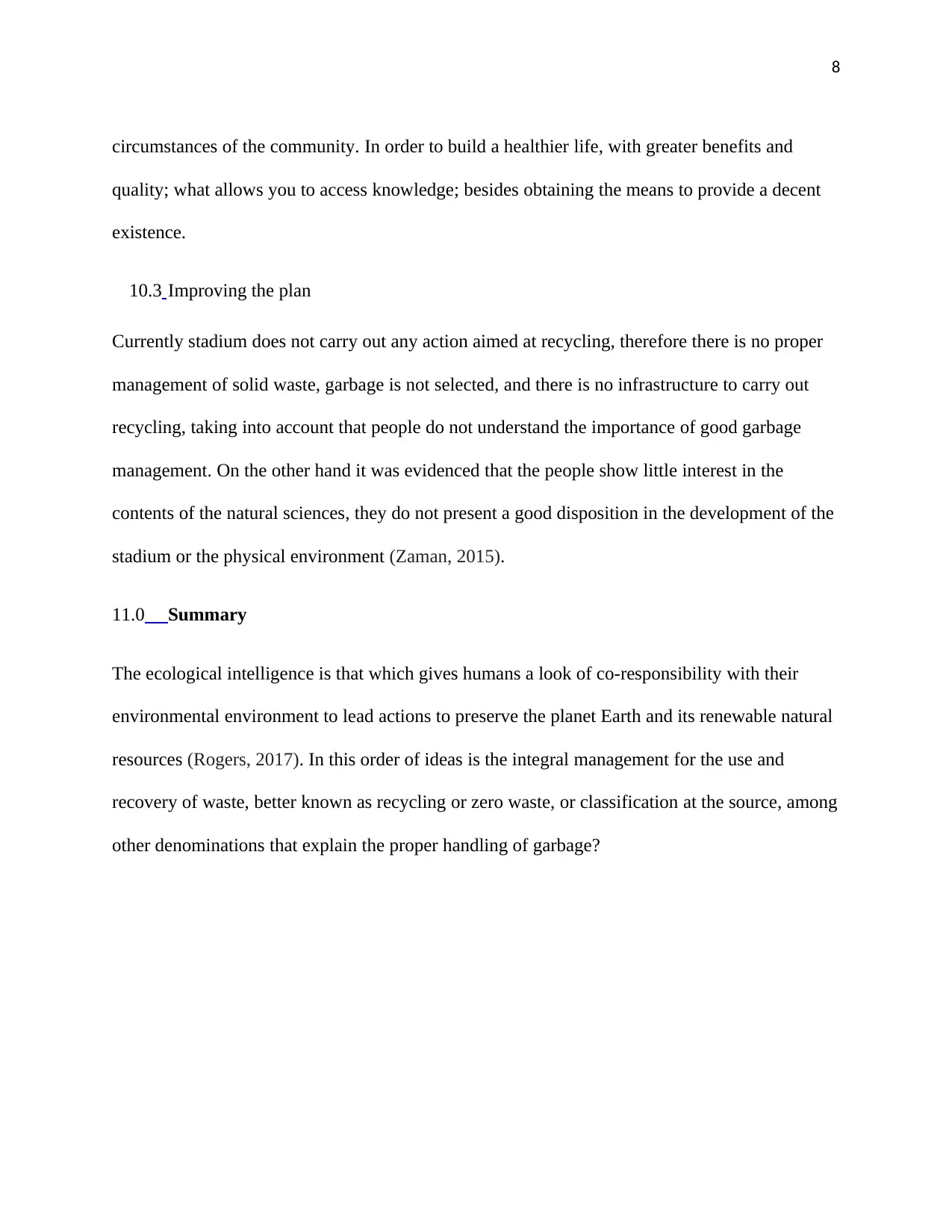
8
circumstances of the community. In order to build a healthier life, with greater benefits and
quality; what allows you to access knowledge; besides obtaining the means to provide a decent
existence.
10.3 Improving the plan
Currently stadium does not carry out any action aimed at recycling, therefore there is no proper
management of solid waste, garbage is not selected, and there is no infrastructure to carry out
recycling, taking into account that people do not understand the importance of good garbage
management. On the other hand it was evidenced that the people show little interest in the
contents of the natural sciences, they do not present a good disposition in the development of the
stadium or the physical environment (Zaman, 2015).
11.0 Summary
The ecological intelligence is that which gives humans a look of co-responsibility with their
environmental environment to lead actions to preserve the planet Earth and its renewable natural
resources (Rogers, 2017). In this order of ideas is the integral management for the use and
recovery of waste, better known as recycling or zero waste, or classification at the source, among
other denominations that explain the proper handling of garbage?
circumstances of the community. In order to build a healthier life, with greater benefits and
quality; what allows you to access knowledge; besides obtaining the means to provide a decent
existence.
10.3 Improving the plan
Currently stadium does not carry out any action aimed at recycling, therefore there is no proper
management of solid waste, garbage is not selected, and there is no infrastructure to carry out
recycling, taking into account that people do not understand the importance of good garbage
management. On the other hand it was evidenced that the people show little interest in the
contents of the natural sciences, they do not present a good disposition in the development of the
stadium or the physical environment (Zaman, 2015).
11.0 Summary
The ecological intelligence is that which gives humans a look of co-responsibility with their
environmental environment to lead actions to preserve the planet Earth and its renewable natural
resources (Rogers, 2017). In this order of ideas is the integral management for the use and
recovery of waste, better known as recycling or zero waste, or classification at the source, among
other denominations that explain the proper handling of garbage?
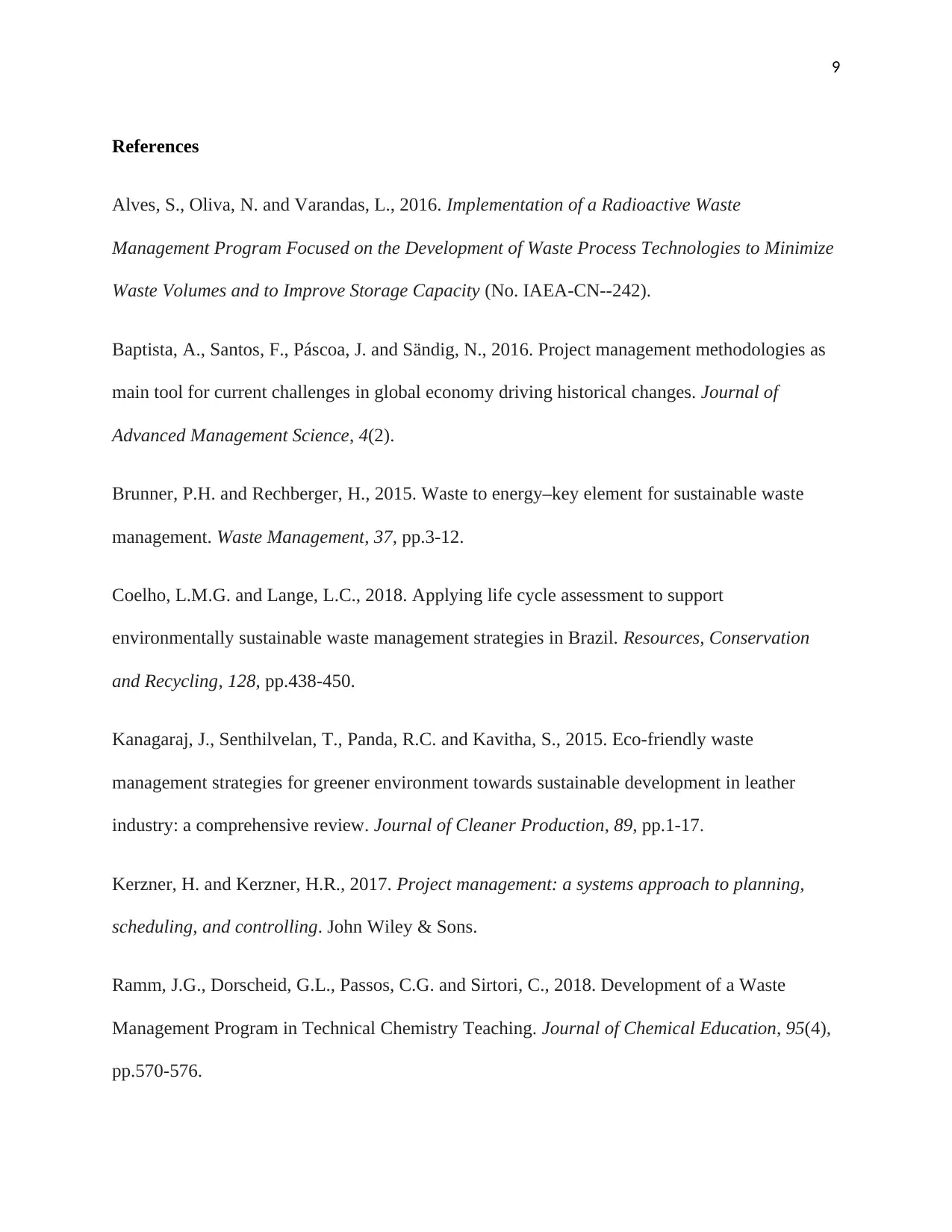
9
References
Alves, S., Oliva, N. and Varandas, L., 2016. Implementation of a Radioactive Waste
Management Program Focused on the Development of Waste Process Technologies to Minimize
Waste Volumes and to Improve Storage Capacity (No. IAEA-CN--242).
Baptista, A., Santos, F., Páscoa, J. and Sändig, N., 2016. Project management methodologies as
main tool for current challenges in global economy driving historical changes. Journal of
Advanced Management Science, 4(2).
Brunner, P.H. and Rechberger, H., 2015. Waste to energy–key element for sustainable waste
management. Waste Management, 37, pp.3-12.
Coelho, L.M.G. and Lange, L.C., 2018. Applying life cycle assessment to support
environmentally sustainable waste management strategies in Brazil. Resources, Conservation
and Recycling, 128, pp.438-450.
Kanagaraj, J., Senthilvelan, T., Panda, R.C. and Kavitha, S., 2015. Eco-friendly waste
management strategies for greener environment towards sustainable development in leather
industry: a comprehensive review. Journal of Cleaner Production, 89, pp.1-17.
Kerzner, H. and Kerzner, H.R., 2017. Project management: a systems approach to planning,
scheduling, and controlling. John Wiley & Sons.
Ramm, J.G., Dorscheid, G.L., Passos, C.G. and Sirtori, C., 2018. Development of a Waste
Management Program in Technical Chemistry Teaching. Journal of Chemical Education, 95(4),
pp.570-576.
References
Alves, S., Oliva, N. and Varandas, L., 2016. Implementation of a Radioactive Waste
Management Program Focused on the Development of Waste Process Technologies to Minimize
Waste Volumes and to Improve Storage Capacity (No. IAEA-CN--242).
Baptista, A., Santos, F., Páscoa, J. and Sändig, N., 2016. Project management methodologies as
main tool for current challenges in global economy driving historical changes. Journal of
Advanced Management Science, 4(2).
Brunner, P.H. and Rechberger, H., 2015. Waste to energy–key element for sustainable waste
management. Waste Management, 37, pp.3-12.
Coelho, L.M.G. and Lange, L.C., 2018. Applying life cycle assessment to support
environmentally sustainable waste management strategies in Brazil. Resources, Conservation
and Recycling, 128, pp.438-450.
Kanagaraj, J., Senthilvelan, T., Panda, R.C. and Kavitha, S., 2015. Eco-friendly waste
management strategies for greener environment towards sustainable development in leather
industry: a comprehensive review. Journal of Cleaner Production, 89, pp.1-17.
Kerzner, H. and Kerzner, H.R., 2017. Project management: a systems approach to planning,
scheduling, and controlling. John Wiley & Sons.
Ramm, J.G., Dorscheid, G.L., Passos, C.G. and Sirtori, C., 2018. Development of a Waste
Management Program in Technical Chemistry Teaching. Journal of Chemical Education, 95(4),
pp.570-576.
You're viewing a preview
Unlock full access by subscribing today!
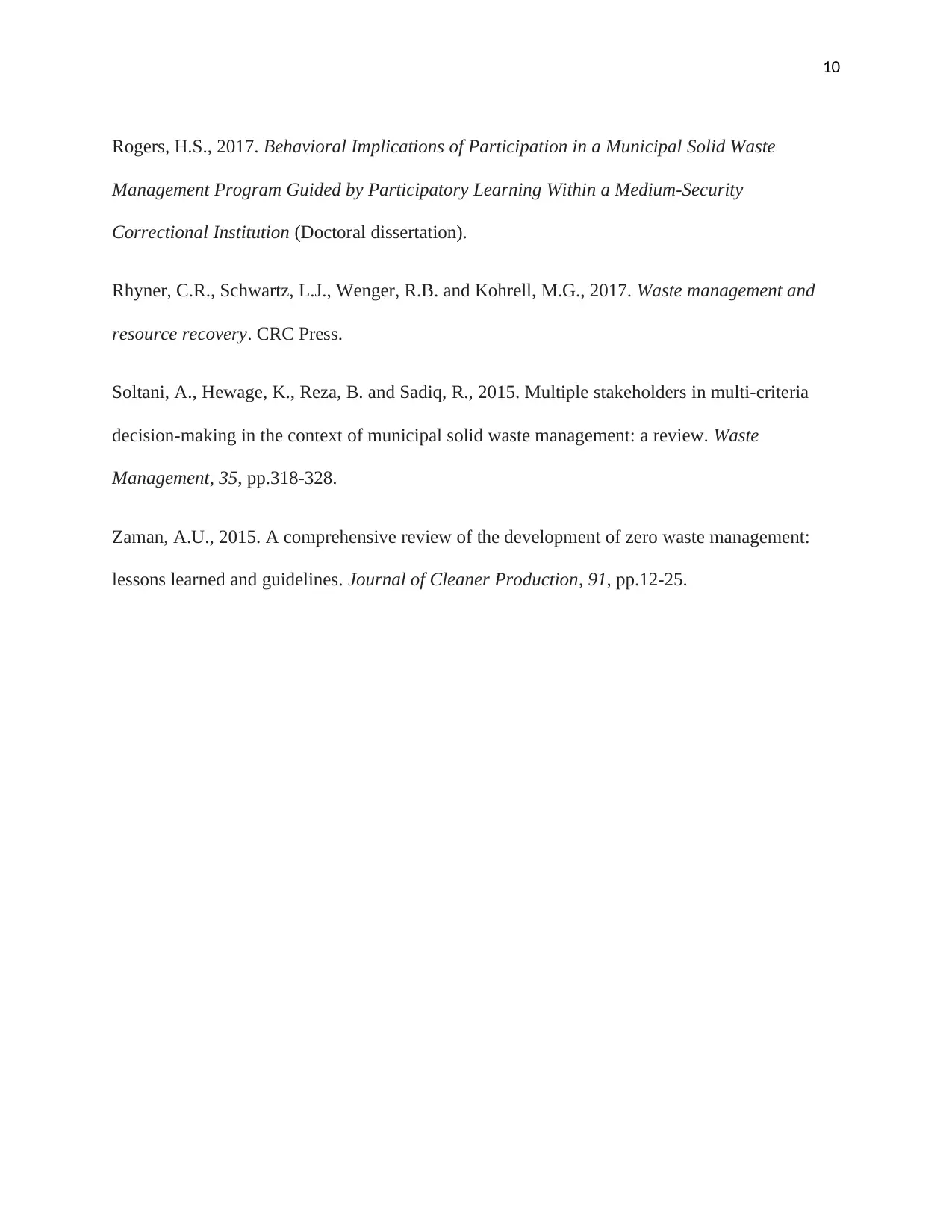
10
Rogers, H.S., 2017. Behavioral Implications of Participation in a Municipal Solid Waste
Management Program Guided by Participatory Learning Within a Medium-Security
Correctional Institution (Doctoral dissertation).
Rhyner, C.R., Schwartz, L.J., Wenger, R.B. and Kohrell, M.G., 2017. Waste management and
resource recovery. CRC Press.
Soltani, A., Hewage, K., Reza, B. and Sadiq, R., 2015. Multiple stakeholders in multi-criteria
decision-making in the context of municipal solid waste management: a review. Waste
Management, 35, pp.318-328.
Zaman, A.U., 2015. A comprehensive review of the development of zero waste management:
lessons learned and guidelines. Journal of Cleaner Production, 91, pp.12-25.
Rogers, H.S., 2017. Behavioral Implications of Participation in a Municipal Solid Waste
Management Program Guided by Participatory Learning Within a Medium-Security
Correctional Institution (Doctoral dissertation).
Rhyner, C.R., Schwartz, L.J., Wenger, R.B. and Kohrell, M.G., 2017. Waste management and
resource recovery. CRC Press.
Soltani, A., Hewage, K., Reza, B. and Sadiq, R., 2015. Multiple stakeholders in multi-criteria
decision-making in the context of municipal solid waste management: a review. Waste
Management, 35, pp.318-328.
Zaman, A.U., 2015. A comprehensive review of the development of zero waste management:
lessons learned and guidelines. Journal of Cleaner Production, 91, pp.12-25.
1 out of 10
Related Documents
Your All-in-One AI-Powered Toolkit for Academic Success.
+13062052269
info@desklib.com
Available 24*7 on WhatsApp / Email
![[object Object]](/_next/static/media/star-bottom.7253800d.svg)
Unlock your academic potential
© 2024 | Zucol Services PVT LTD | All rights reserved.





